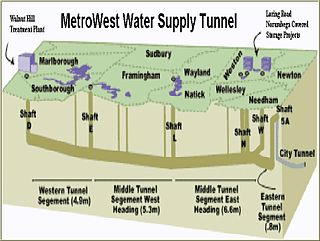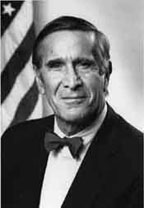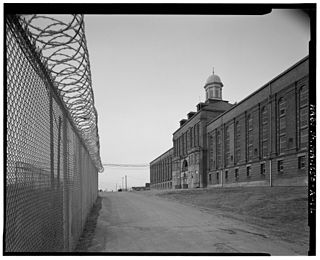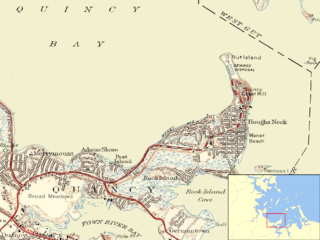
The Massachusetts Water Resources Authority (MWRA) is a public authority in the Commonwealth of Massachusetts that provides wholesale drinking water and sewage services to certain municipalities and industrial users in the state, primarily in the Boston area.

Boston Harbor is a natural harbor and estuary of Massachusetts Bay, and is located adjacent to the city of Boston, Massachusetts. It is home to the Port of Boston, a major shipping facility in the Northeastern United States.

Conservation Law Foundation (CLF) is an environmental advocacy organization based in New England. Since 1966, CLF's mission has been to advocate for New England's environment and its communities. CLF's advocacy work takes place across five integrated program areas: Clean Energy & Climate Change, Clean Air & Water, Healthy Oceans, People & Justice, and Healthy Communities. CLF uses the law, science, and the market to create solutions that preserve natural resources, build healthy communities, and sustain a vibrant economy. CLF works to promote renewable energy and fight air and water pollution; build sustainable fishing communities and protect marine habitat; promote public transit and defend public health; achieve environmental justice; and sustain a vibrant, equitable economy.

Moon Island is an island in Quincy Bay, in the middle of Boston Harbor, Massachusetts. It is the location of the Boston Fire Department Training Academy, and Boston Police Department shooting range. All of the land on the island is owned by the City of Boston but the island is under the jurisdiction of Quincy, Massachusetts. It is also part of the Boston Harbor Islands National Recreation Area.
The Boston Harbor Islands Partnership is a non-profit partnership organization based in Boston, MA, whose purpose is "to coordinate the activities of the Federal, State, and local authorities and the private sector in the development and implementation of a general management plan" for the Boston Harbor Islands National Recreation Area. The Partnership was established by the United States Congress in 1996, as part of the law which designated the Boston Harbor Islands as a unit of the national parks system.

The Wachusett Aqueduct is a secondary aqueduct that carries water from the Wachusett Reservoir to the John J. Carroll Water Treatment Plant at Walnut Hill in Marlborough, Massachusetts. It is part of the public water supply system for the communities of Greater Boston that are served by the Massachusetts Water Resources Authority (MWRA), which manages the aqueduct. The aqueduct serves as a standby backup to the Cosgrove Tunnel.

The Deer Island Waste Water Treatment Plant is located on Deer Island, one of the Boston Harbor Islands in Boston Harbor. The plant is operated by the Massachusetts Water Resources Authority (MWRA) and began partial operations in 1995. The facility was fully operational in 2000 with the completion of the outfall tunnel.

The MetroWest Water Supply Tunnel (MWWST) is an advanced underground aqueduct that supplies potable water to residents of much of Greater Boston. It is part of the Massachusetts Water Resources Authority (MWRA) water supply system, having entered operation in November 2003.

Chestnut Hill Reservoir is a reservoir created in 1870 on existing marshes and meadowland to supplement the city of Boston's water needs, located in its namesake neighborhood of Chestnut Hill. A 1.56 mile jogging loop abuts the reservoir. Chestnut Hill Reservoir was taken offline in 1978 as it was no longer needed for regular water supply distribution, but is maintained in emergency backup status. It is recognized today on the National Register of Historic Places and was designated as a Boston Landmark by the Boston Landmarks Commission in 1989.

Armando David Mazzone served for twenty-six years as a United States district judge of the United States District Court for the District of Massachusetts.

The Fore River Railroad is a class III railroad in eastern Massachusetts owned by the Massachusetts Water Resources Authority (MWRA) and operated by the Fore River Transportation Corporation. It was originally built in 1902 and opened in 1903 as a rail link between the Fore River Shipyard at Quincy Point and the New York, New Haven and Hartford Railroad in East Braintree, a length of 2.7 miles (4.3 km). Originally an integral part of the shipyard, the Fore River Railroad was incorporated as a separate company in 1919 by Bethlehem Steel, which purchased the shipyard itself during World War I.
Paul F. Levy is an American businessman, author, professor, and was elected on Nov 2, 2021 to a two-year term for the Ward 6 seat on the Newton (MA) School Committee. He is noted for his use of social media in health care leadership roles, and has been the subject of academic research and Harvard Business School case studies about the role of social media in important and complex negotiations.

Clean Harbors, Inc. is an American provider of environmental and industrial services, including hazardous waste disposal for companies, small waste generators and federal, state, provincial and local governments.

The Metropolitan Park System of Greater Boston is a system of reservations, parks, parkways and roads under the control of the Massachusetts Department of Conservation and Recreation (DCR) in and around Boston that has been in existence for over a century. The title is used by the DCR to describe the areas collectively: "As a whole, the Metropolitan Park System is currently eligible for listing on the National Register of Historic Places", as outlined on the department's website. The DCR maintains a separate Urban Parks and Recreation division to oversee the system, one of five such divisions within the department—DCR's Bureau of State Parks and Recreation manages the remainder of Massachusetts state parks. Direct design and maintenance functions for the parkways and roads within the system are provided by the DCR Bureau of Engineering.

The Deer Island Prison in Suffolk County, Massachusetts was located on Deer Island in Boston Harbor. Once known as the Deer Island House of Industry and later, House of Correction, it held people convicted of drunkenness, illegal possession of drugs, disorderly conduct, larceny, and other crimes subject to relatively short-term sentencing. When it closed in 1991, some 1,500 inmates were being held at Deer Island.
The 2010 Boston water emergency occurred on May 1, 2010, when a water pipe in Weston, Massachusetts, broke and began flooding into the Charles River. This led to unsanitary water conditions in the greater Boston area, which resulted in Governor Deval Patrick declaring a state of emergency and an order for residents to boil drinking water. The leak was stopped on May 2. On May 4, the order was lifted. President Barack Obama signed an emergency disaster declaration offering federal help, authorizing the Department of Homeland Security and Federal Emergency Management Agency to coordinate disaster relief efforts with Massachusetts.

Nut Island is a former island in Boston Harbor, part of the Boston Harbor Islands National Recreation Area. The island has been connected through a short causeway to the end of Houghs Neck, becoming part of the mainland of Quincy, Massachusetts.
William Brownell Golden is an American attorney and politician who represented the Norfolk and Plymouth district in the Massachusetts Senate from 1985 to 1991. He was a candidate for Lieutenant Governor of Massachusetts in 1990, but lost in the Democratic primary to Marjorie Clapprood.
The South Boston CSO Storage Tunnel, also known as the North Dorchester Bay CSO Storage Tunnel, is a large underground facility designed to reduce untreated sewage discharges into Boston Harbor from the Massachusetts Water Resources Authority combined sewer and stormwater system. It was opened on July 23, 2011, and is part of the federally mandated Boston Harbor Cleanup project. CSO stands for Combined Sewer Overflow.

The John J. Carroll Water Treatment Plant (CWTP) is a water treatment plant operated since 2005 by the Massachusetts Water Resources Authority (MWRA) to treat water bound for Greater Boston. The plant is located at the town lines of Marlborough, Northborough, and Southborough, Massachusetts.















